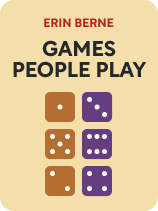

This article is an excerpt from the Shortform book guide to "Games People Play" by Eric Berne. Shortform has the world's best summaries and analyses of books you should be reading.
Like this article? Sign up for a free trial here .
What is Eric Berne’s Games People Play about? How can you tell someone is playing a game on you?
Games People Play is Berne’s 1964 classic about the many ways that we habitually relate to one another through “games.” These aren’t fun, harmless social games, though—they’re subtle, largely unconscious patterns that harm us and our relationships. Berne explains how most of us don’t even notice our games, and how we’re missing out on the fulfillment of game-free living.
Keep reading to learn about Berne’s concept of “games” and why we play them.
Defining “Games” People Play
According to Eric Berne, games are set, stereotypical patterns of interaction. Think of it as an “act” that someone puts on—for example, a husband who regularly explodes, apologizes, then acts like it never happened. This pattern can occur across thousands of households, and so can any other game—the same “acts” occur in many specific instances throughout a population.
In this way, games are almost natural phenomena. They’re like migration patterns, or bird mating dances. Berne is simply saying, “Look! Here are all these consistent, identifiable patterns in the fabric of human social exchange,” in the same way an ecologist points out patterns in a forest ecosystem.
(Shortform note: Insofar as the approach of science is to find and confirm patterns in the fabric of reality, Berne’s approach here is quite scientific. A 2006 paper in the Transactional Analysis Journal argues that Berne was a phenomenologist: He observed patterns across thousands of patients and described what he saw. This contrasts with Freud’s work, which relied heavily on individual case studies. But you need a large, representative sample to accurately generalize any psychological phenomenon across a population, in order to buffer the effect of outliers that might skew results in a smaller sample size. Freud, however, extrapolated much of his theory from a small set of his patients—which is why much of it isn’t considered empirical.)
Games in Plain Language
So a game is a natural phenomenon, a pattern. Now let’s look at the characteristics of this kind of pattern.
A game is a habitual way of behaving. Games are social—we play them in our close relationships. Each game follows a consistent sequence of “moves,” aimed toward an (unconsciously) desired outcome. That aim is typically to reinforce an existing stance of yours.
In this example, try to spot the four aspects mentioned above. This game, called “Mr. Vesuvius,” continues the previous example. It goes like this:
- Mr. Vesuvius is a regular working man in regular suburban America. He’s a hard worker and provides for his family, but struggles with emotionality.
- Failing to manage his daily stressors, pressure gradually builds in Mr. Vesuvius. Then his kid or wife steps slightly awry, and suddenly Mr. Vesuvius erupts. A shattered cup becomes an excuse to pour weeks of pent-up frustration out onto the unfortunate family member. They don’t understand how hard he works, they give him no respect, and never show him any care.
- Eventually his anger wanes, and he walks off. He comes back to apologize, but pivots sharply to explain how justified the eruption was. Soon after, he’s laughing and smiling once more.
You might know this game; it’s fairly common. We’ll look more closely at each move of a game, and their functions, throughout this part of the guide. First, two more important aspects of games:
- We play games unconsciously. These are not intentional social games, like learned strategies for flirting or debating. Mr. Vesuvius isn’t consciously choosing to behave as such—he’s stuck in a game. (And because we aren’t aware of the games we play, Berne later recommends that we develop self-awareness so we can escape them.)
- Games are typically unhealthy. A game is driven by some unhealthy, underlying belief, usually resulting from childhood trauma (here Freud’s influence on Berne is apparent). Take for example Mr. Vesuvius’s belief that “People won’t respect me if I’m kind, so I should strike first.” In Berne’s view, that belief causes him to create situations that reinforce the belief.
| Games and Mindfulness In the 1960s, mindfulness hadn’t yet surged in popularity as it has today. If it had, might Berne have made use of the effects it can have on psychological growth? As Berne notes, one of the primary characteristics of games is that we play them unconsciously. One of the primary functions of mindfulness meditation is to train your awareness, which heightens how conscious you are to normally unconscious aspects of your experience. Mindfulness correlates positively with successful behavioral change, and it seems to be effective for treating everything from substance abuse to binge eating. Closer to Berne’s main interest, Mindfulness-Based Relationship Enhancement (MBRE) has been found to improve empathy, shared well-being, and communication in intimate relationships—it’s hard to imagine he wouldn’t have taken an interest in such an effective tool. |
Games in Terms of Transactional Analysis
With games explained in plain language, let’s look at a few more of Berne’s technical distinctions.
In a game, each player acts according to an underlying motive. These come from their beliefs, and players aren’t conscious of them. Berne isn’t clear about this, but we can infer that a player’s motive is typically to reinforce their stance. So if Player A believes “I am essentially unlovable,” she’ll play a game that tries to prove this. It follows that…
Games are dishonest. Unaware of the habits they’re stuck in, the player of a game tries to manipulate, provoke, or otherwise cause the other to prove her right. Again, this manipulation isn’t conscious. Berne says this is a key characteristic of games.
Say for example that Player A struggles to accept love. She shies away from affection, and starts to lash out when her romantic partner gets too close. Eventually the other feels spurned, insults her in a fit of anger—and so, her belief is confirmed.
(Shortform note: Berne’s view of games seems fairly deterministic: He seems to believe that, in most cases, people are ignorant of the psychological forces driving their behaviors, and incapable of acting otherwise. While 1960s culture may have been less self-aware, we’ve become increasingly focused on personal development, with more and more people engaging in awareness practices like mindfulness. The problems Berne indicates remain: We’re still susceptible to behaving without thinking, and cognitive biases often have us uncritically seeking confirmation of our beliefs. But in theory, dishonest relational styles may grow less prevalent as our culture continues to invest in personal growth: Widely held goals like achieving happiness, fulfillment, and well-being aren’t compatible with dishonest, deceptive behavior.)
Games aren’t blatantly dishonest, though. On the surface, games look like superficially believable interactions, and the underlying motive isn’t obvious. Often, neither player consciously knows the game they’re playing. These are deceptive exchanges at play: You say one thing, but mean another.
Berne would say that the woman above appears to be upset with her partner, but it’s actually about a deeper psychological issue—her self-destructive belief.
People play games that complement one another’s—Player A’s game fits like a puzzle piece into Player B’s game. Berne gives the example of “Wooden Leg” (we’ll call this “Poor Little Me”), where Player A leverages any minor hurt to shirk their responsibilities. This enables Player B to play “You Lazy Bum,” harrying Player A into their work. Player A now feels even more pitiable, which in turn leads Player B to pity them even less.
Games are dramatic—there’s usually some confrontation or emotional flare-up, like a fight over where to go for dinner. This happens in “Cornered,” where a simple plan for dinner or dancing gets derailed when one player triggers some sore spot in the other, and an argument ensues.
An argument is often the game’s “payoff,” the end result the players seek. Berne states that the players appear to be upset but are secretly pleased, because the fighting confirms their stances.
(Shortform note: Berne’s idea of a “payoff” at the end of a game seems to anticipate the idea of rewards from the habit loop. In short, you perform a habit because there’s a reward at the end, usually some form of pleasure that, on a neural level, offers dopamine. In Berne’s model, the game’s “payoff” is the reward—one that usually validates your beliefs—while Charles Duhigg’s notion of rewards is more general. James Clear introduced the idea of “cravings,” to explain how we’re drawn into repeating habits. Berne may have intuited this notion as well, as he later characterizes games as indulgences—very close to cravings.)

———End of Preview———
Like what you just read? Read the rest of the world's best book summary and analysis of Eric Berne's "Games People Play" at Shortform .
Here's what you'll find in our full Games People Play summary :
- The many ways that we relate to one another through “games”
- Why you might be missing out on the fulfillment of game-free living
- How to identify and overcome unhealthy games






